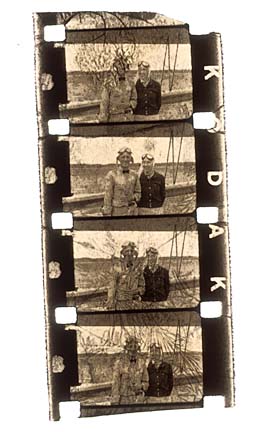

DRAWN & QUARTERED

|
We think of the universe as analog, but it's really digital. It's just that the bits are so small -- atom-size! Learn to control the individual bits, and the elements will follow. It's true for atomic energy. It's also true for visual information such as photographs, films and comic strips. Digital tricks vividly
restore historyStar-Bulletin Staff
Nothing will replace the work of masters, where the personal touch of the artist is evident. On the other hand, original work fades. It's a constant of the universe -- molecular decay, chemical entropy. Time wounds all fields. But any work that is designed to be reproduced can be brought back to life, restored and even improved by using digital technology. And it can then be stored indefinitely, because the 0/1, yes/no, on/off coding of digital data is, literally, a black-and-white issue. There's no albedo.
It's a matter of data storage, which is getting cheaper all the time, and talented, professional labor, which is getting more expensive all the time.

|
A couple of years ago, I was asked to reprint a comic-book story I had originally drawn in the early '80s. Or maybe it was the late '70s. I dug 'em out. The originals were made on "chemical board," a kind of imprinted paper that, when painted with a variety of watery chemicals, turned dark with diagonal lines. It was a way of making gray shades that would reproduce well on newsprint.The originals, however, over the years had bled together so that the neat and crisp gray areas were now fuzzy and indistinct. They were in bad shape.
The only solution was to make high-resolution scans and then clean them up. It was labor-intensive and I considered simply redrawing them. But no, I wanted to preserve the look of the original art, and so they gradually were brought back to life.
I also was able to redo the junky lettering and e-mail the images to the publisher. And I had a permanent image that wouldn't degrade!
You don't need to be a fine artist to do such work. Some computer skill, common sense and tasteful restraint are all that's needed.
Now consider all the graphic works that have vanished, leaving behind only their printed remains, like pop-cultural fossils. Most comic strips were drawn on cheap paper or shirt cardboards and tossed out when completed. Animation cells were dumped. Photographs fade. Movie negatives crumble, or burst into flame.
Such works are part of our cultural heritage, and preserving them is a moral imperative.
It can also be an economic necessity. The recent re-rendering of Disney's "Beauty and the Beast" was possible only because the movie was stored on 5,000 CD-ROMs when it was made 10 years ago. (Nowadays, it would be stored on 500 DVDs.) Disney was able to cash in on its work again (and advance the copyright date) thanks to digital technology.
This works on anything, given the right slathering of technological savvy. Old "Krazy Kat" strips that exist only in the page of yellowing newspapers.
Here's an example of what could be done. An old newsreel film of a 1939 air show at Honolulu's John Rogers Field sadly was allowed to deteriorate until it literally was crumbling into bits.
Normally, film archivists and historians would just shake their heads and toss the reel into the trash. But bits and fragments of the film were peeled off and examined, and whole frames placed into glass slide holders. One such fragment is shown on the previous page.
It then was scanned at high resolution and run through some simple digital algorithms that corrected the exposure density. It then was cleaned up slightly for the result shown in the other image. It isn't fancy, but you can recognize the people photographed so long ago. If this had been an important historical event, such information could be useful.
Other computer programs have been written that would take a lot of the labor out of the process, automatically filling scratches, erasing emulsion wrinkles and such.
Not just images can be treated to this type of digital archaeology. A friend whose former band's music existed only on decaying cassette tape had the music restored simply by exporting the files to a computer for electronic cleanup, including repairing dropouts and tape hiss. The tunes now are doing well on mp3.com.
The process is not restricted to massive restoration projects. Imagine tweaking and accenting. Pre-1930 films often suffer from varying exposures on each frame, creating that flickering effect. The exposures can be evened out, creating a smoother viewing experience. Scratches and breaks also can be repaired.
When George Lucas updated the original "Star Wars," he fixed a lot of things (except the light sabers!) and added more details. The re-release was a commercial success, and nothing opens eyes in Hollywood like money rolling in. (What other films could be tweaked?) But Lucas did it, he claimed, to make his vision of the film truer to what he had in mind.
There are plenty of perfectly good older films that would be fabulous in theaters but don't make it because of limitations. George Pal's "War of the Worlds," for example, features models with wires holding them up and composite shots that don't match; "Lawrence of Arabia" has turned purple; "Those Magnificent Men in Their Flying Machines" has scratchy prints. All could be restored to their former glory for new generations. Any film can benefit.
But who will do the labor?
Why not prisoners? They've got time on their hands, could use a marketable skill -- and they need to repay their debt to society.
Click for online
calendars and events.